Freshly Milled Quartz Particles Obtained from River Sand as an Efficient Natural Demulsifier for Crude Oil Emulsions
Abstract
:1. Introduction
2. Materials and Methods
2.1. Materials
2.2. Sand Sample Milling
2.3. Preparation of the Water-in-Oil Emulsion
2.4. Demulsification Tests
2.5. Rheological Measurements
2.6. Interfacial Tension Measurements
2.7. Characterization of Sand and Emulsion
3. Results and Discussion
3.1. Characterization of the Sand Sample and w/o Emulsion
3.2. Demulsification Performance of the Untreated and Freshly Milled Quartz Particles
3.3. Viscosity Behavior
3.4. Interfacial Tension Measurements
3.5. Proposed Mechanism of w/o Demulsification by Freshly Milled Quartz
4. Conclusions
Author Contributions
Funding
Institutional Review Board Statement
Informed Consent Statement
Data Availability Statement
Conflicts of Interest
References
- Wong, S.F.; Lim, J.S.; Dol, S.S. Crude oil emulsion: A review on formation, classification and stability of water-in-oil emulsions. J. Pet. Sci. Eng. 2015, 135, 498–504. [Google Scholar] [CrossRef]
- Kilpatrick, P.K. Water-in-crude oil emulsion stabilization: Review and unanswered questions. Energy Fuels 2012, 26, 4017–4026. [Google Scholar] [CrossRef]
- Greaves, D.; Boxall, J.; Mulligan, J.; Sloan, E.D.; Koh, C.A. Hydrate formation from high water content-crude oil emulsions. Chem. Eng. Sci. 2008, 63, 4570–4579. [Google Scholar] [CrossRef]
- Martínez-Palou, R.; de Lourdes Mosqueira, M.; Zapata-Rendón, B.; Mar-Juárez, E.; Bernal-Huicochea, C.; de la Cruz Clavel-López, J.; Aburto, J. Transportation of heavy and extra-heavy crude oil by pipeline: A review. J. Pet. Sci. Eng. 2011, 75, 274–282. [Google Scholar] [CrossRef]
- Kolotova, D.S.; Kuchina, Y.A.; Petrova, L.A.; Voron’ko, N.G.; Derkach, S.R. Rheology of water-in-crude oil emulsions: Influence of concentration and temperature. Colloids Interfaces 2018, 2, 64. [Google Scholar] [CrossRef] [Green Version]
- Ghosh, S.; Rousseau, D. Fat crystals and water-in-oil emulsion stability. Curr. Opin. Colloid Interface Sci. 2011, 16, 421–431. [Google Scholar] [CrossRef]
- Kang, W.; Xu, B.; Wang, Y.; Li, Y.; Shan, X.; An, F.; Liu, J. Stability mechanism of W/O crude oil emulsion stabilized by polymer and surfactant. Colloids Surf. A Physicochem. Eng. Asp. 2011, 384, 555–560. [Google Scholar] [CrossRef]
- Ghannam, M.T. Water-in-crude oil emulsion stability investigation. Pet. Sci. Technol. 2005, 23, 649–667. [Google Scholar] [CrossRef]
- Spiecker, P.M.; Gawrys, K.L.; Trail, C.B.; Kilpatrick, P.K. Effects of petroleum resins on asphaltene aggregation and water-in-oil emulsion formation. Colloids Surf. A Physicochem. Eng. Asp. 2003, 220, 9–27. [Google Scholar] [CrossRef]
- Xu, X.; Cao, D.; Liu, J.; Gao, J.; Wang, X. Research on ultrasound-assisted demulsification/dehydration for crude oil. Ultrason. Sonochem. 2019, 57, 185–192. [Google Scholar] [CrossRef]
- Adeyemi, I.; Meribout, M.; Khezzar, L. Recent developments, challenges, and prospects of ultrasound-assisted oil technologies. Ultrason. Sonochem. 2021, 82, 105902. [Google Scholar] [CrossRef] [PubMed]
- Nadirova, Z.K.; Ivakhnenko, O.P.; Zhantasov, M.K.; Bimbetova, G.Z.; Nadirov, K.S. Ultrasound-assisted dewatering of crude oil from Kumkol oilfield. Chem. Bull. Kazakh Natl. Univ. 2021, 101, 4–10. [Google Scholar] [CrossRef]
- Santos, D.; da Rocha, E.C.; Santos, R.L.; Cancelas, A.J.; Franceschi, E.; Santos, A.F.; Dariva, C. Demulsification of water-in-crude oil emulsions using single mode and multimode microwave irradiation. Sep. Purif. Technol. 2017, 189, 347–356. [Google Scholar] [CrossRef]
- Lv, X.; Song, Z.; Yu, J.; Su, Y.; Zhao, X.; Sun, J.; Wang, W. Study on the demulsification of refinery oily sludge enhanced by microwave irradiation. Fuel 2020, 279, 118417. [Google Scholar] [CrossRef]
- Ezzati, A.; Gorouhi, E.; Mohammadi, T. Separation of water in oil emulsions using microfiltration. Desalination 2005, 185, 371–382. [Google Scholar] [CrossRef]
- Akbari, S.; Nour, A.; Jamari, S.; Rajabi, A. Demulsification of water-in-crude oil emulsion via conventional heating and microwave heating technology in their optimum conditions. Aust. J. Basic Appl. Sci. 2016, 10, 66–74. [Google Scholar]
- Fan, M.; Nie, C.; Du, H.; Ni, J.; Wang, B.; Wang, X. An insight into the solar demulsification of highly emulsified water produced from oilfields by monitoring the viscosity, zeta potential, particle size and rheology. Colloids Surf. A Physicochem. Eng. Asp. 2019, 575, 144–154. [Google Scholar] [CrossRef]
- Nie, C.; Du, H.; Zhang, Y.; Han, G.; Wang, H.; Yuan, D.; Wang, X. Towards efficient solar demulsification (I): A solar electrical role on interfacial film of emulsions. Sustain. Mater. Technol. 2021, 30, e00344. [Google Scholar] [CrossRef]
- Xu, B. Fast and Energy-efficient Demulsification for Crude Oil Emulsions Using Pulsed Electric Field. Int. J. Electrochem. Sci. 2017, 12, 9242–9249. [Google Scholar] [CrossRef]
- Taleghani, S.T.; Jahromi, A.F.; Elektorowicz, M. Electro-demulsification of water-in-oil suspensions enhanced with implementing various additives. Chemosphere 2019, 233, 157–163. [Google Scholar] [CrossRef]
- Alao, K.T.; Alara, O.R.; Abdurahman, N.H. Trending approaches on demulsification of crude oil in the petroleum industry. Appl. Petrochem. Res. 2021, 11, 281–293. [Google Scholar] [CrossRef]
- Saad, M.A.; Kamil, M.; Abdurahman, N.H.; Yunus, R.M.; Awad, O.I. An overview of recent advances in state-of-the-art techniques in the demulsification of crude oil emulsions. Processes 2019, 7, 470. [Google Scholar] [CrossRef] [Green Version]
- Abdulredha, M.M.; Aslina, H.S.; Luqman, C.A. Overview on petroleum emulsions, formation, influence and demulsification treatment techniques. Arab. J. Chem. 2020, 13, 3403–3428. [Google Scholar] [CrossRef]
- Otarbaev, N.S.; Kapustin, V.M.; Nadirov, K.S.; Bimbetova, G.Z.; Zhantasov, M.K.; Nadirov, R.K. New potential demulsifiers obtained by processing gossypol resin. Indones. J. Chem. 2019, 19, 959–966. [Google Scholar] [CrossRef] [Green Version]
- Roostaie, T.; Farsi, M.; Rahimpour, M.R.; Biniaz, P. Performance of biodegradable cellulose based agents for demulsification of crude oil: Dehydration capacity and rate. Sep. Purif. Technol. 2017, 179, 291–296. [Google Scholar] [CrossRef]
- Shehzad, F.; Hussein, I.A.; Kamal, M.S.; Ahmad, W.; Sultan, A.S.; Nasser, M.S. Polymeric surfactants and emerging alternatives used in the demulsification of produced water: A review. Polym. Rev. 2018, 58, 63–101. [Google Scholar] [CrossRef]
- Du, Y.; Si, P.; Wei, L.; Wang, Y.; Tu, Y.; Zuo, G.; Ye, S. Demulsification of acidic oil-in-water emulsions driven by chitosan loaded Ti3C2Tx. Appl. Surf. Sci. 2019, 476, 878–885. [Google Scholar] [CrossRef]
- Feng, X.; Wang, S.; Hou, J.; Wang, L.; Cepuch, C.; Masliyah, J.; Xu, Z. Effect of hydroxyl content and molecular weight of biodegradable ethylcellulose on demulsification of water-in-diluted bitumen emulsions. Ind. Eng. Chem. Res. 2011, 50, 6347–6354. [Google Scholar] [CrossRef]
- Abullah, M.M.; Al-Lohedan, H.A.; Attah, A.M. Synthesis and application of amphiphilic ionic liquid based on acrylate copolymers as demulsifier and oil spill dispersant. J. Mol. Liq. 2016, 219, 54–62. [Google Scholar] [CrossRef]
- Atta, A.M.; Al-Lohedan, H.A.; Abdullah, M.M. Dipoles poly (ionic liquids) based on 2-acrylamido-2-methylpropane sulfonic acid-co-hydroxyethyl methacrylate for demulsification of crude oil water emulsions. J. Mol. Liq. 2016, 222, 680–690. [Google Scholar] [CrossRef]
- Ezzat, A.O.; Atta, A.M.; Al-Lohedan, H.A.; Abdullah, M.M.; Hashem, A.I. Synthesis and application of poly (ionic liquid) based on cardanol as demulsifier for heavy crude oil water emulsions. Energy Fuels 2018, 32, 214–225. [Google Scholar] [CrossRef]
- Ismail, A.I.; Atta, A.M.; El-Newehy, M.; El-Hefnawy, M.E. Synthesis and Application of New Amphiphilic Asphaltene Ionic Liquid Polymers to Demulsify Arabic Heavy Petroleum Crude Oil Emulsions. Polymers 2020, 12, 1273. [Google Scholar] [CrossRef] [PubMed]
- Adewunmi, A.A.; Kamal, M.S.; Solling, T.I. Application of magnetic nanoparticles in demulsification: A review on synthesis, performance, recyclability, and challenges. J. Pet. Sci. Eng. 2020, 196, 107680. [Google Scholar] [CrossRef]
- Chen, Y.; Lin, X.; Liu, N.; Cao, Y.; Lu, F.; Xu, L.; Feng, L. Magnetically recoverable efficient demulsifier for water-in-oil emulsions. ChemPhysChem 2015, 16, 595–600. [Google Scholar] [CrossRef]
- Zhou, J.; Sui, H.; Ma, J.; Li, X.; Al-Shiaani, N.H.; He, L. Fast demulsification of oil-water emulsions at room temperature by functionalized magnetic nanoparticles. Sep. Purif. Technol. 2021, 274, 118967. [Google Scholar] [CrossRef]
- Farrokhi, F.; Jafari Nasr, M.R.; Rahimpour, M.R.; Arjmand, M.; Vaziri, S.A. Application of a novel magnetic nanoparticle as demulsifier for dewatering in crude oil emulsion. Sep. Sci. Technol. 2018, 53, 551–558. [Google Scholar] [CrossRef]
- Nikkhah, M.; Tohidian, T.; Rahimpour, M.R.; Jahanmiri, A. Efficient demulsification of water-in-oil emulsion by a novel nano-titania modified chemical demulsifier. Chem. Eng. Res. Des. 2015, 94, 164–172. [Google Scholar] [CrossRef]
- Huang, Z.; Li, P.; Luo, X.; Jiang, X.; Liu, L.; Ye, F.; Mi, Y. Synthesis of a novel environmentally friendly and interfacially active CNTs/SiO2 demulsifier for W/O crude oil emulsion separation. Energy Fuels 2019, 33, 7166–7175. [Google Scholar] [CrossRef]
- Zhang, X.; Niu, J.; Wu, J.Y. Development and characterization of novel and stable silicon nanoparticles-embedded PCM-in-water emulsions for thermal energy storage. Appl. Energy 2019, 238, 1407–1416. [Google Scholar] [CrossRef]
- Javadian, S.; Sadrpoor, S.M. Demulsification of water in oil emulsion by surface modified SiO2 nanoparticle. J. Pet. Sci. Eng. 2020, 184, 106547. [Google Scholar] [CrossRef]
- Adewunmi, A.A.; Kamal, M.S.; Solling, T.I.; Salami, B.A. Palm oil fuel ash (POFA) as a demulsifier for crude oil emulsions: Performance and mechanism. J. Pet. Sci. Eng. 2019, 183, 106430. [Google Scholar] [CrossRef]
- Knapik, E. Biodemulsification combined with fixed-bed biosorption for the recovery of crude oil from produced water. J. Water Process. Eng. 2020, 38, 101614. [Google Scholar] [CrossRef]
- Hippmann, S.; Ahmed, S.S.; Fröhlich, P.; Bertau, M. Demulsification of water/crude oil emulsion using natural rock Alginite. Colloids Surf. A Physicochem. Eng. Asp. 2018, 553, 71–79. [Google Scholar] [CrossRef]
- Adewunmi, A.A.; Amao, A.O.; Kamal, M.S.; Solling, T.I. Demulsification and breaking mechanism of variable quartz concentrates obtained from sand. J. Pet. Sci. Eng. 2020, 192, 107263. [Google Scholar] [CrossRef]
- Adewunmi, A.A.; Kamal, M.S.; Amao, A.O.; Solling, T.I. Extracted quartz as efficient natural demulsifier for crude oil-water emulsions: Effect of monovalent/divalent salts, pH and modeling study. J. Pet. Sci. Eng. 2021, 206, 109069. [Google Scholar] [CrossRef]
- Parks, G.A. Surface and interfacial free energies of quartz. J. Geophys. Res. Solid Earth 1984, 89, 3997–4008. [Google Scholar] [CrossRef]
- Murashov, V.V.; Demchuk, E. A comparative study of unrelaxed surfaces on quartz and kaolinite, using the periodic density functional theory. J. Phys. Chem. B 2005, 109, 10835–10841. [Google Scholar] [CrossRef]
- Parks, G.A. Surface energy and adsorption at mineral/water interfaces: An introduction. Miner.-Water Interface Geochem. 2018, 23, 133–176. [Google Scholar]
- Dean, E.W.; Stark, D.D. A Convenient Method for the Determination of Water in Petroleum and Other Organic Emulsions. Ind. Eng. Chem. 1920, 12, 486–490. [Google Scholar] [CrossRef] [Green Version]
- Márquez, N.; Antón, R.E.; Graciaa, A.; Lachaise, J.; Salager, J.L. Partitioning of ethoxylated alkylphenol surfactants in microemulsion-oil-water systems. Part II: Influence of hydrophobe branching. Colloids Surface A 1998, 131, 45–49. [Google Scholar] [CrossRef]
- Tao, J.; Shi, P.; Fang, S.; Li, K.; Zhang, H.; Duan, M. Effect of rheology properties of oil/water interface on demulsification of crude oil emulsions. Ind. Eng. Chem. Res. 2015, 54, 4851–4860. [Google Scholar] [CrossRef]
- Kang, W.; Yin, X.; Yang, H.; Zhao, Y.; Huang, Z.; Hou, X.; Aidarova, S. Demulsification performance, behavior and mechanism of different demulsifiers on the light crude oil emulsions. Colloids Surf. A Physicochem. Eng. Asp. 2018, 545, 197–204. [Google Scholar] [CrossRef]
- Strassner, J.E. Effect of pH on interfacial films and stability of crude oil-water emulsions. J. Pet. Technol. 1968, 20, 303–312. [Google Scholar] [CrossRef]
- Arla, D.; Sinquin, A.; Palermo, T.; Hurtevent, C.; Graciaa, A.; Dicharry, C. Influence of pH and water content on the type and stability of acidic crude oil emulsions. Energy Fuels 2007, 21, 1337–1342. [Google Scholar] [CrossRef]
- Behrang, M.; Hosseini, S.; Akhlaghi, N. Effect of pH on interfacial tension reduction of oil (Heavy acidic crude oil, resinous and asphaltenic synthetic oil)/low salinity solution prepared by chloride-based salts. J. Pet. Sci. Eng. 2021, 205, 108840. [Google Scholar] [CrossRef]
- Ahmed, S.M.; Van Cleave, A.B. Adsorption and flotation studies with quartz: Part I. Adsorption of calcium hydrogen and hydroxyl ions on quartz. Can. J. Chem. Eng. 1965, 43, 23–26. [Google Scholar] [CrossRef]
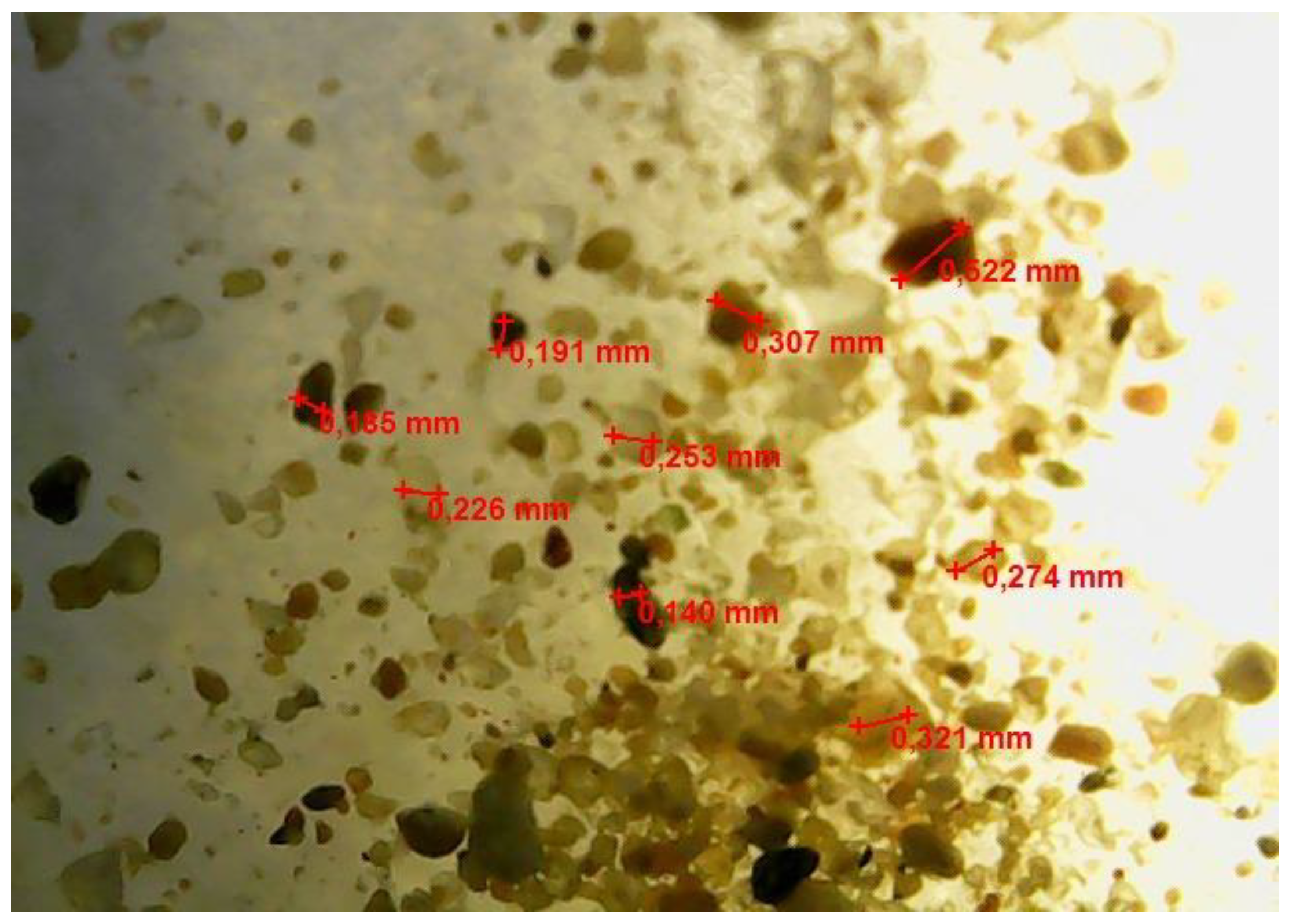
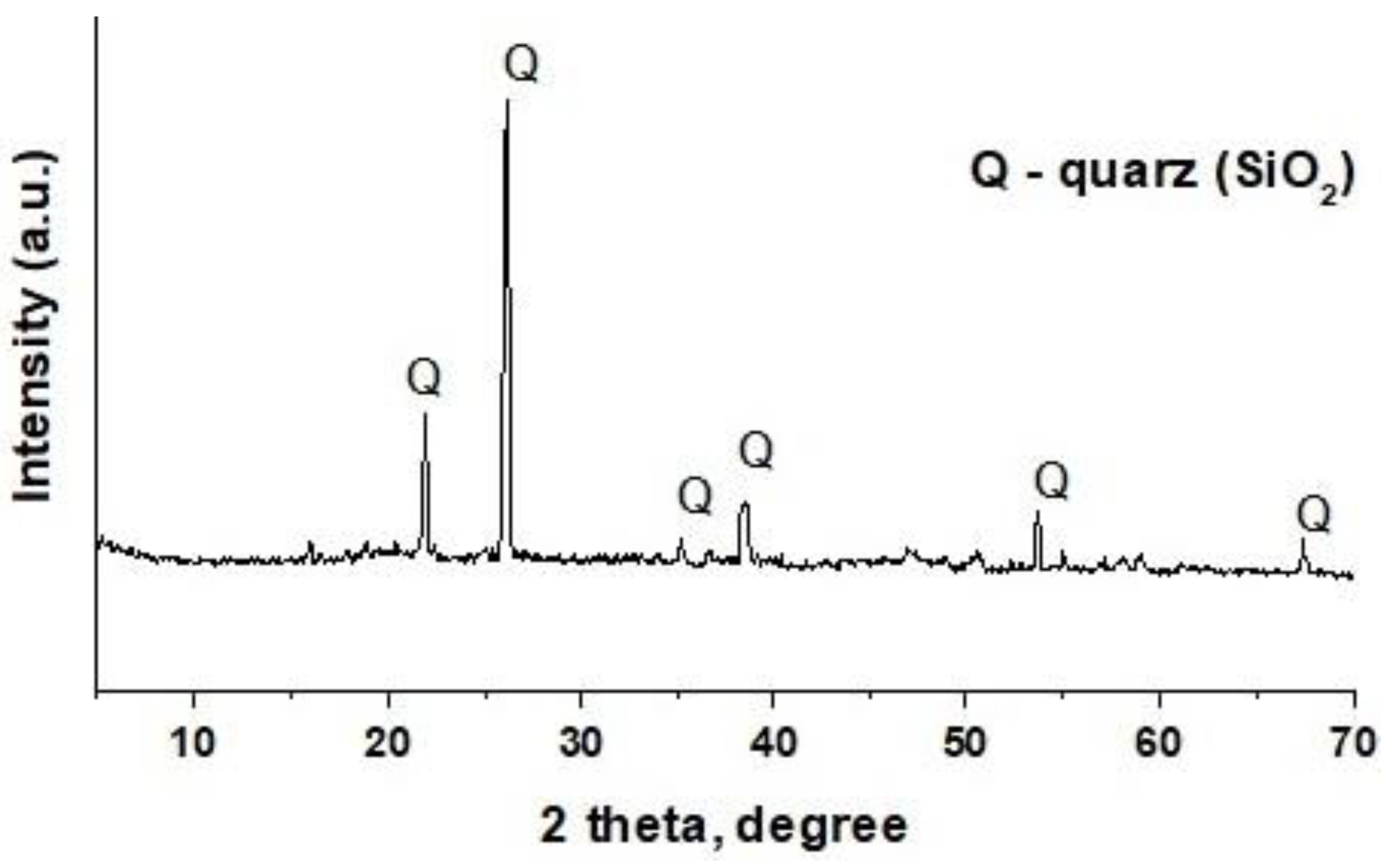
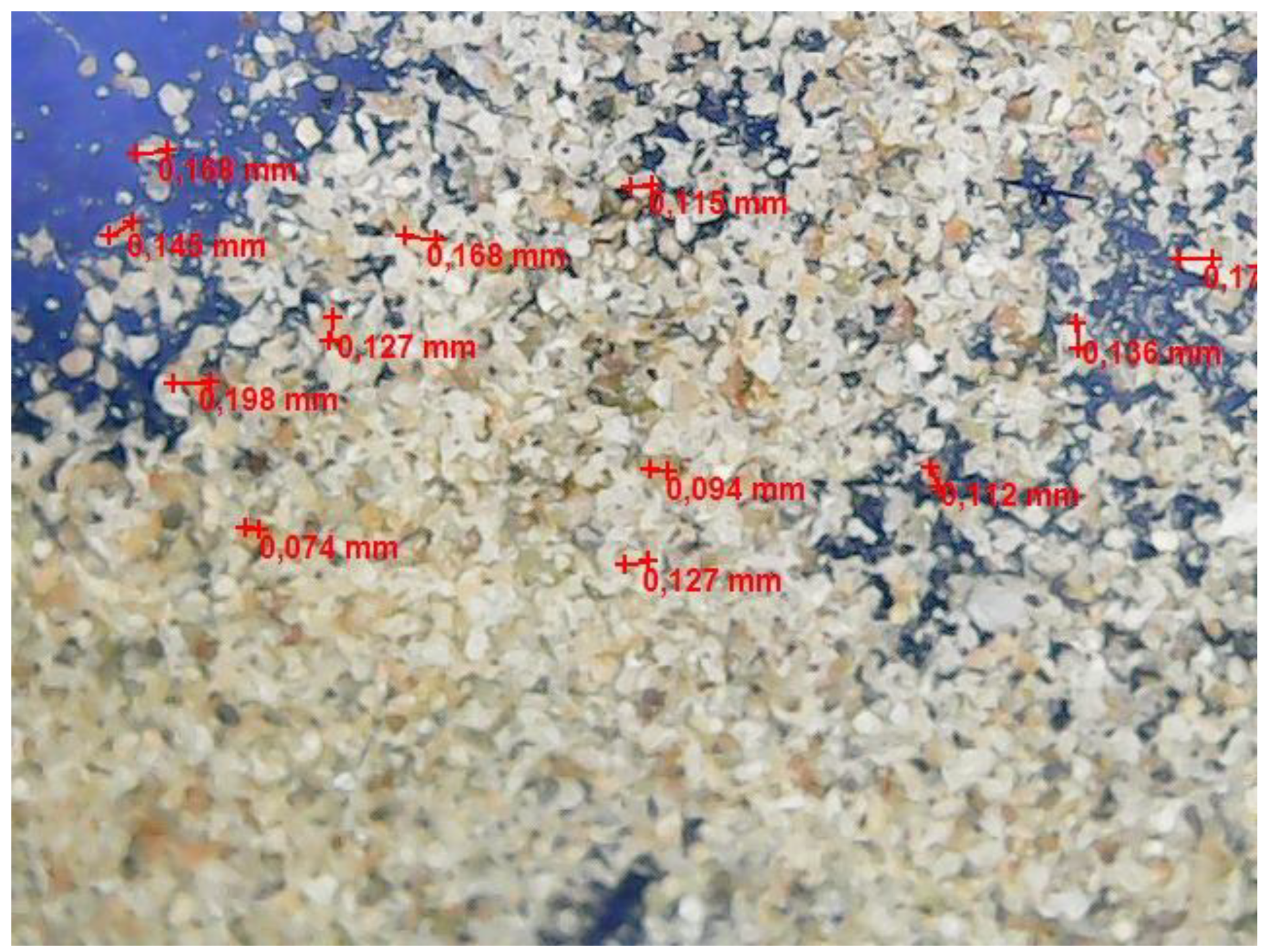


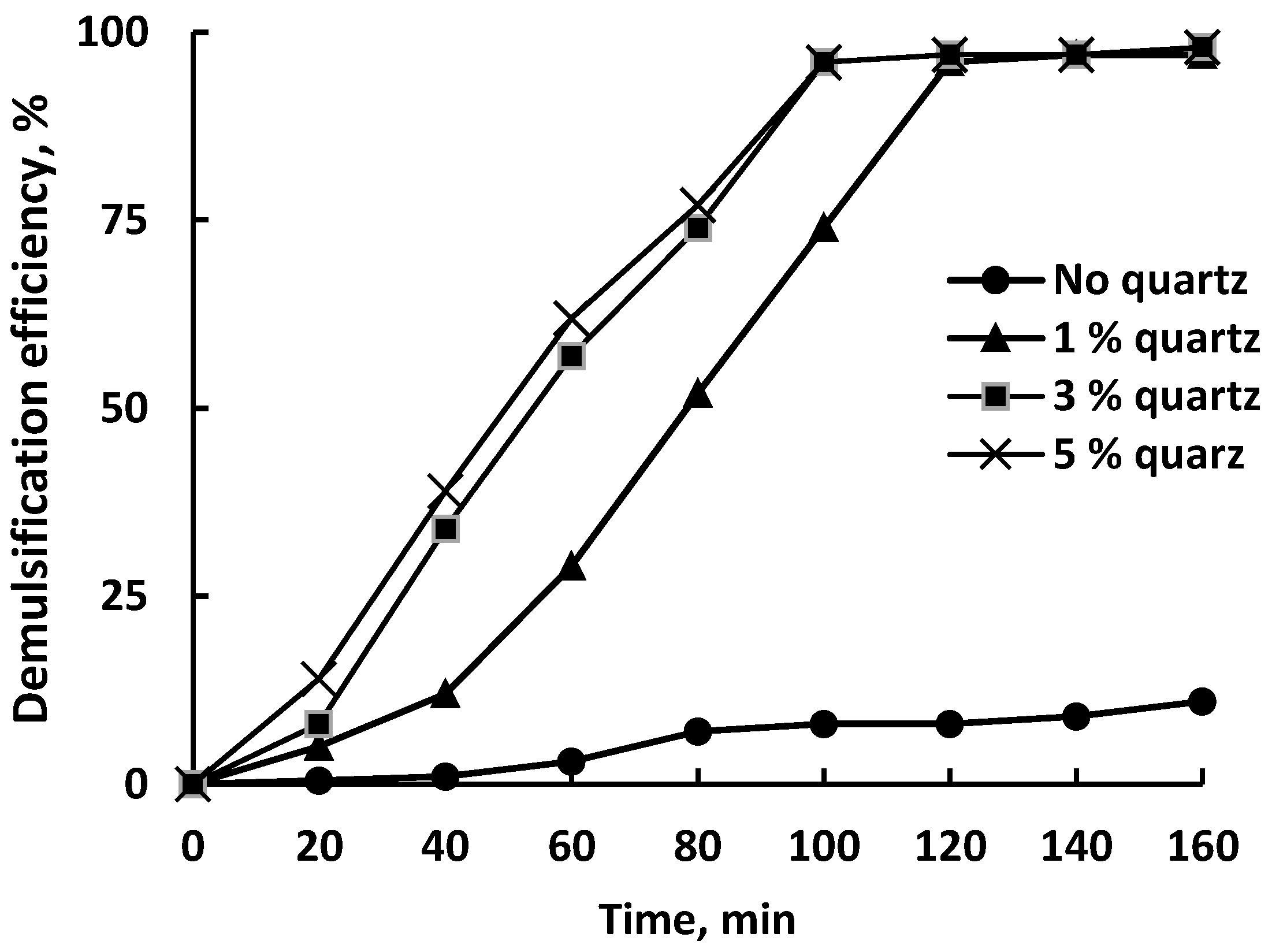
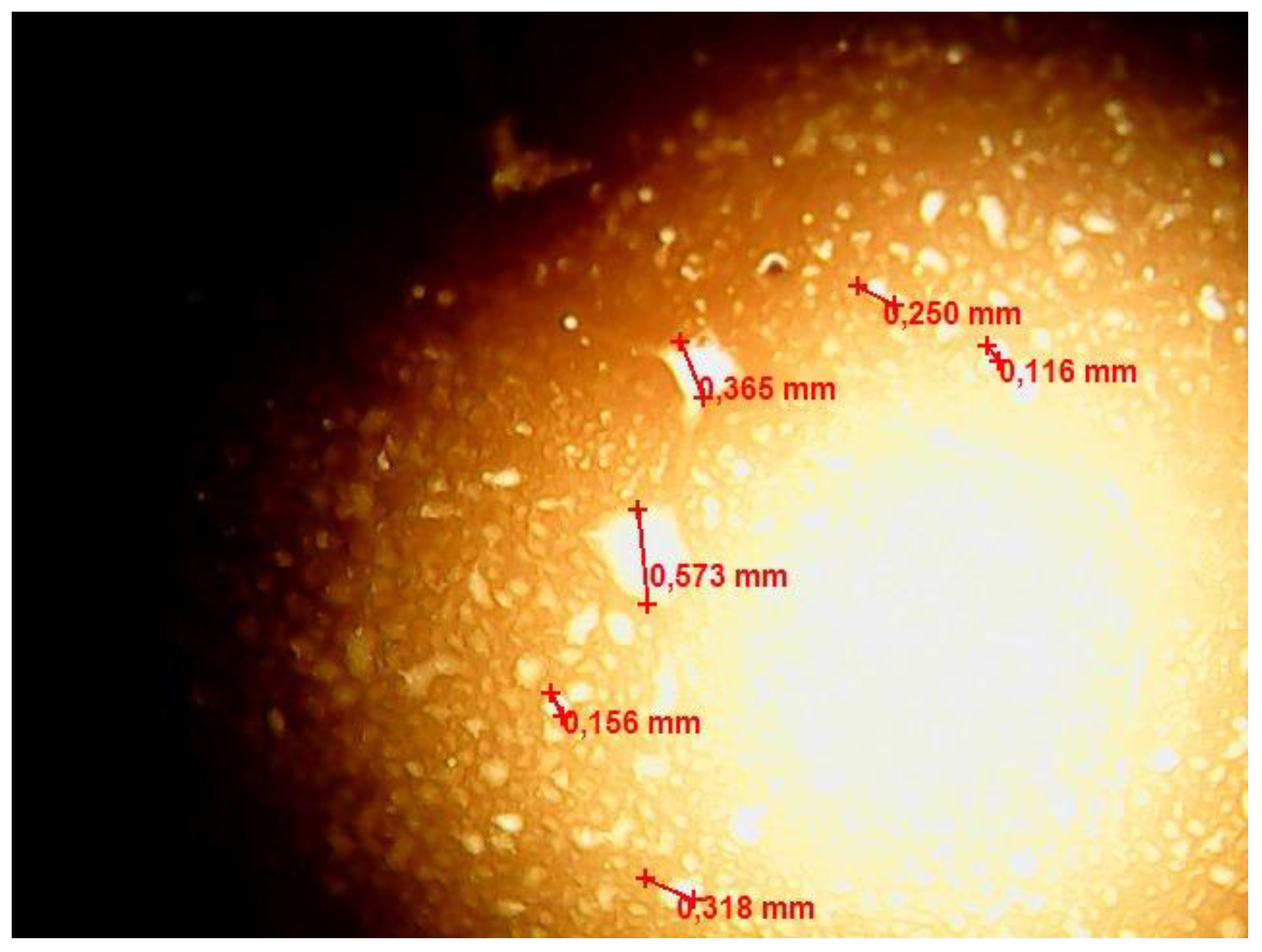
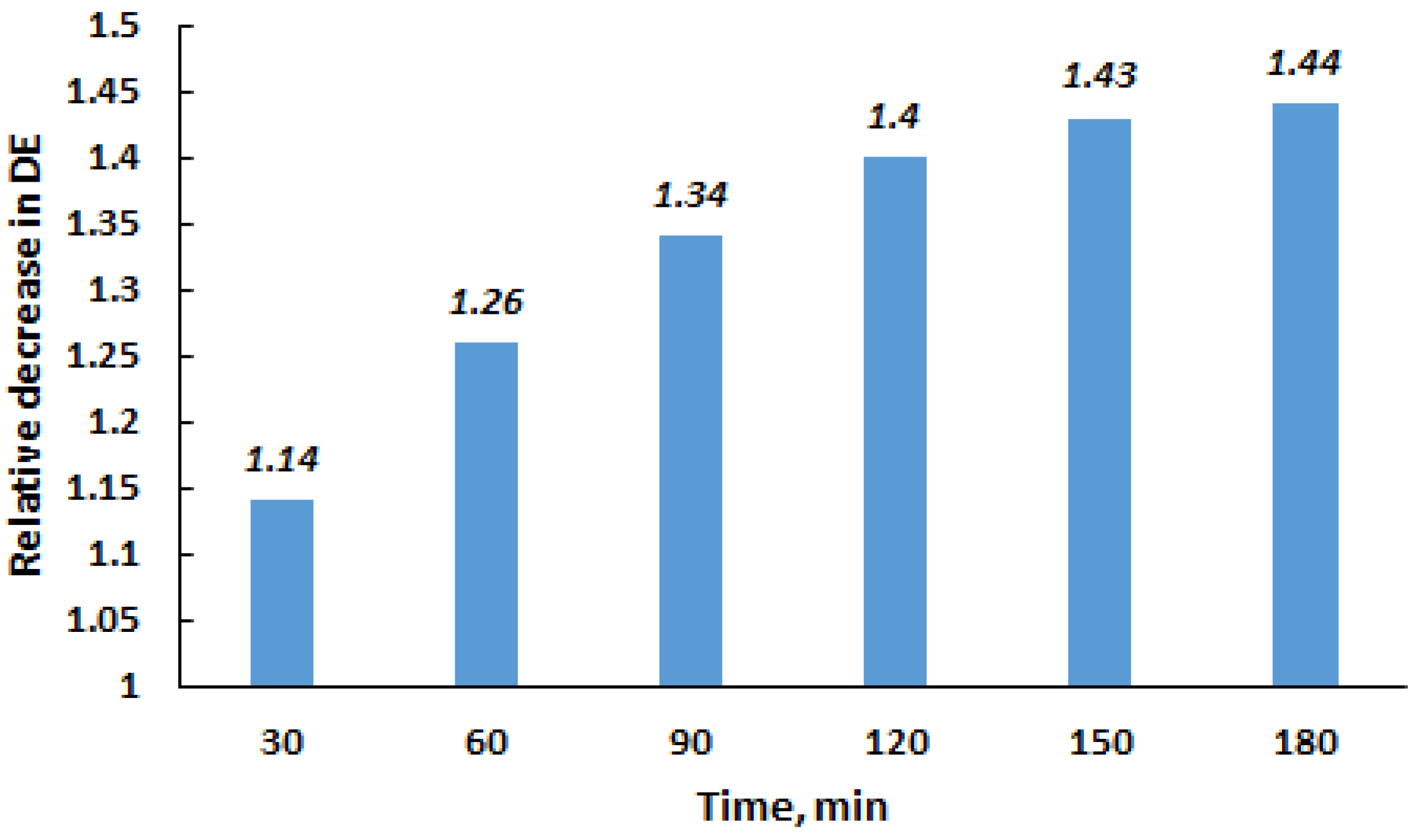
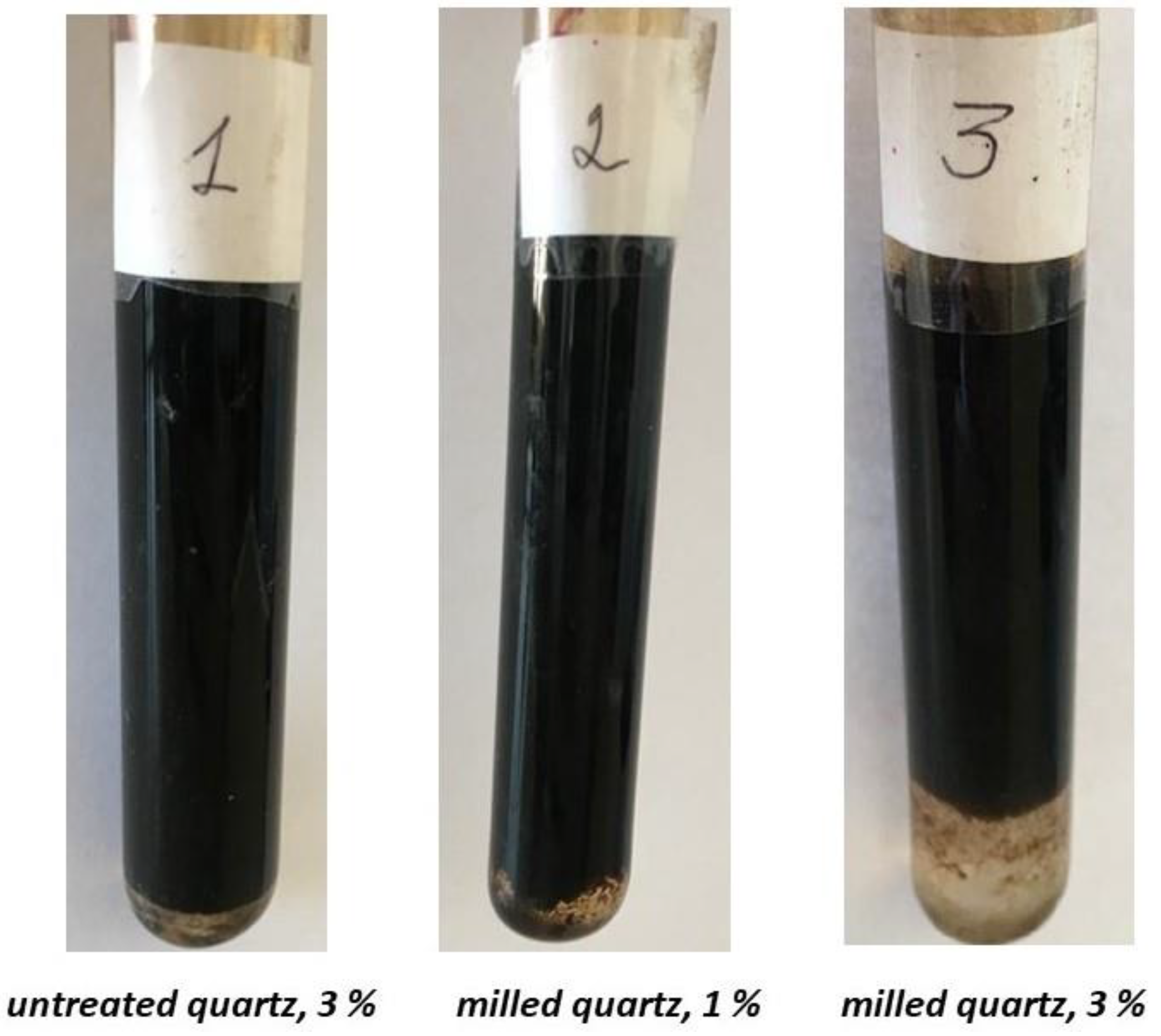
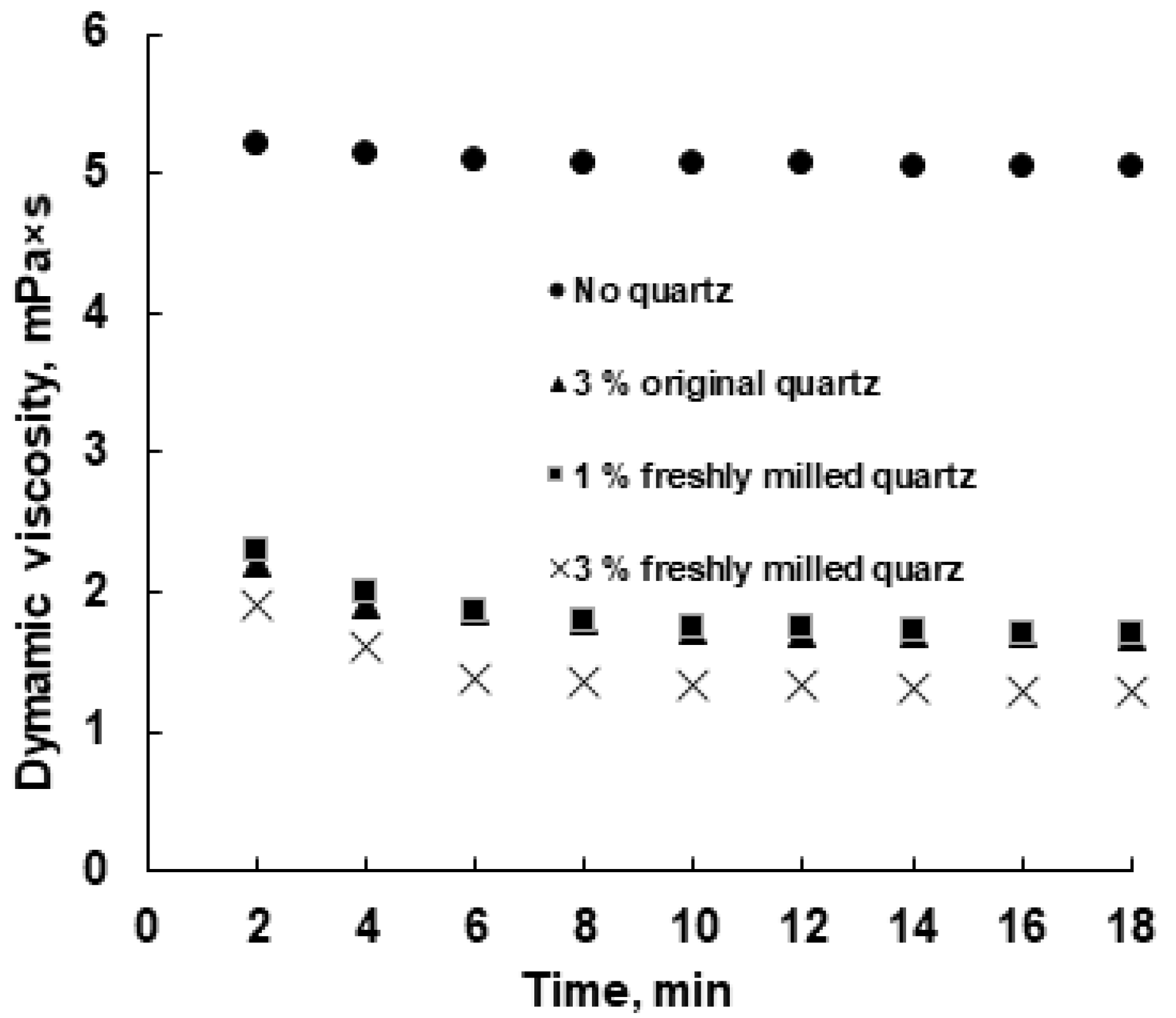
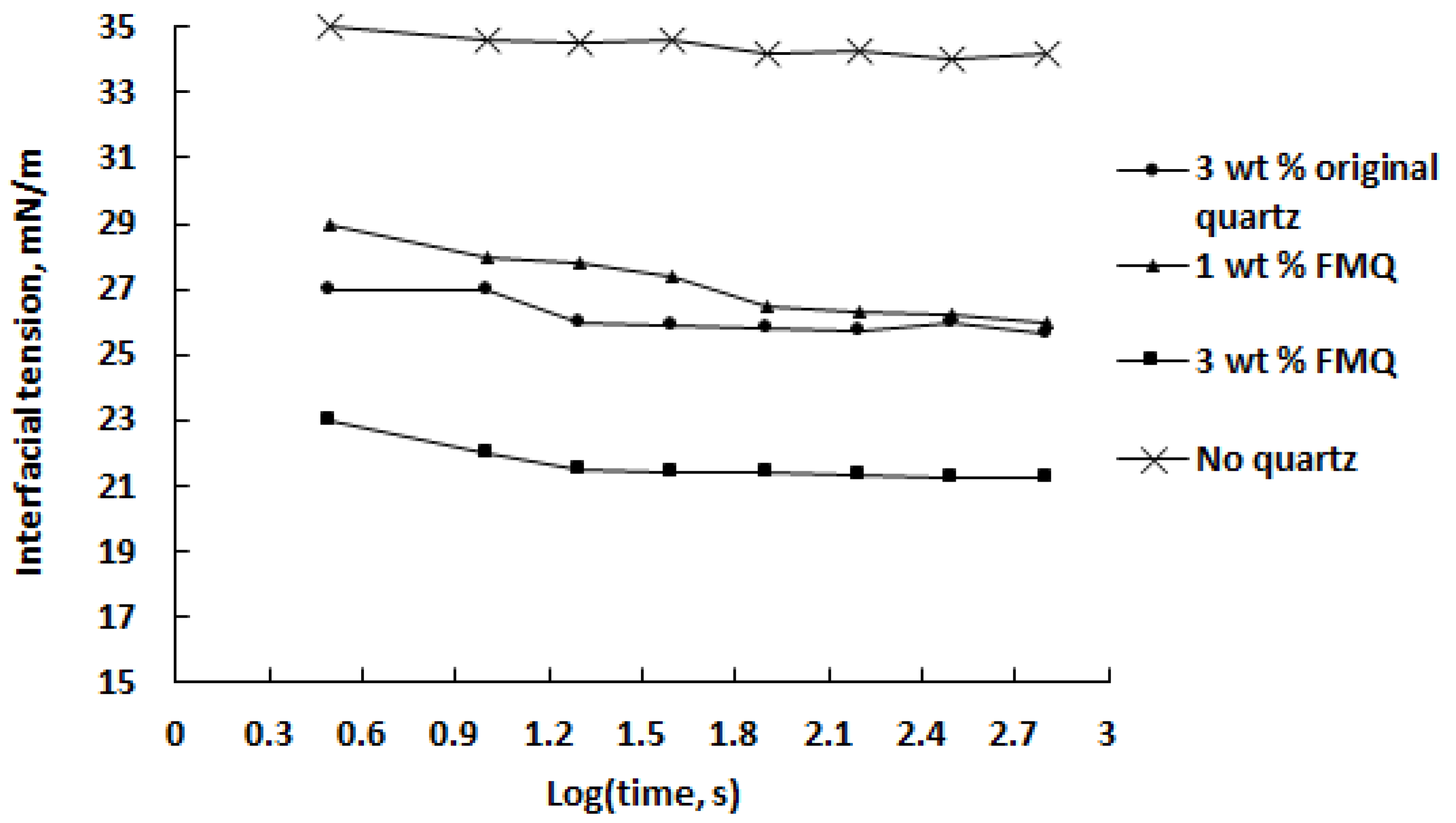
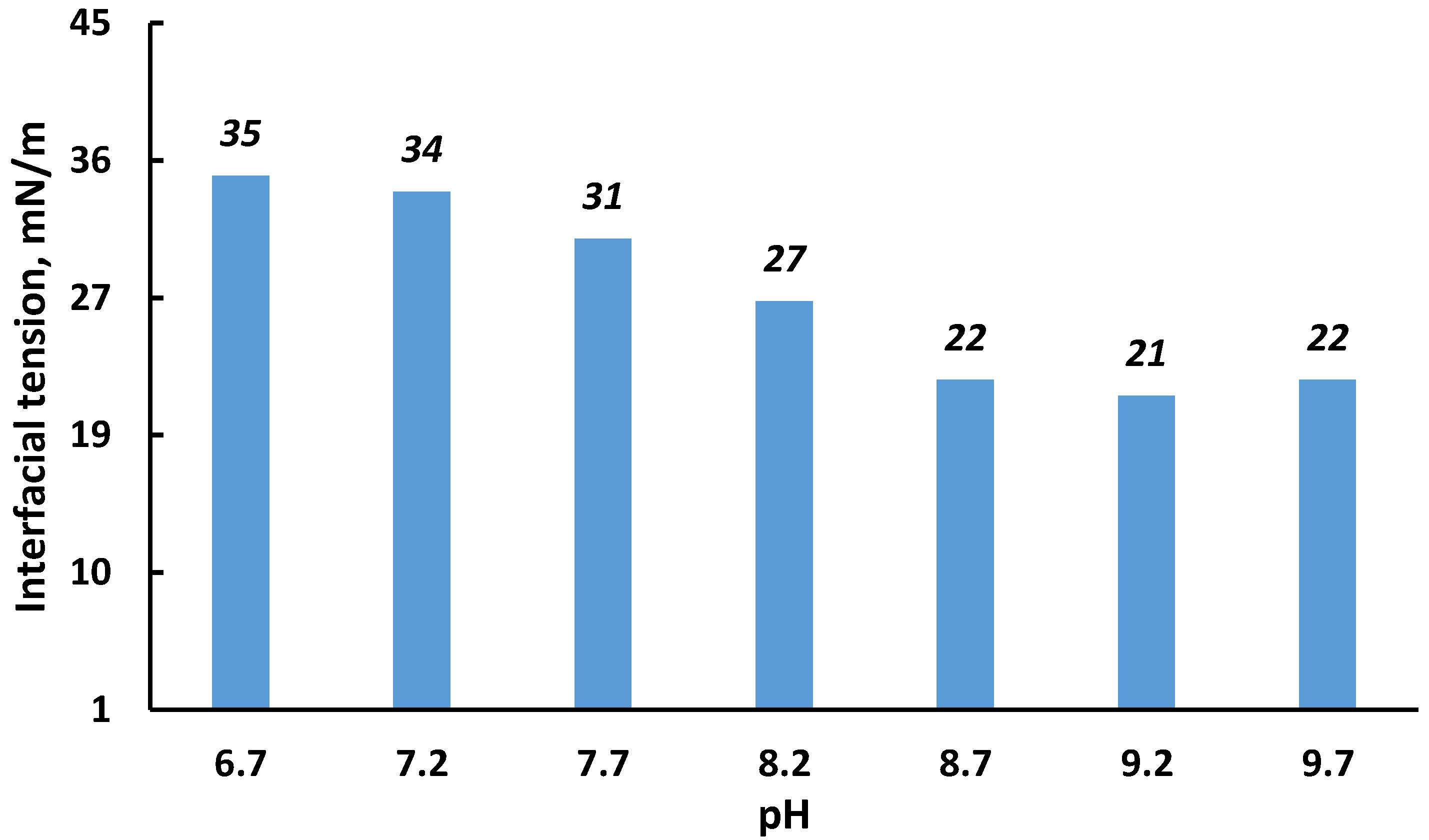
| Characteristic | Value |
|---|---|
| API gravity at 20 °C | 41.2 |
| Density (g/cm3) at 20 °C | 827 |
| Asphaltenes content (wt%) | 0.54 |
| Aromatics content (wt%) | 6.69 |
| Paraffins content (wt%) | 11.28 |
| Resins content (wt%) | 5.06 |
Publisher’s Note: MDPI stays neutral with regard to jurisdictional claims in published maps and institutional affiliations. |
© 2022 by the authors. Licensee MDPI, Basel, Switzerland. This article is an open access article distributed under the terms and conditions of the Creative Commons Attribution (CC BY) license (https://creativecommons.org/licenses/by/4.0/).
Share and Cite
Nadirov, K.; Zhantasov, M.; Nadirova, Z.; Otarbaev, N.; Bimbetova, G.; Nadirov, R. Freshly Milled Quartz Particles Obtained from River Sand as an Efficient Natural Demulsifier for Crude Oil Emulsions. Processes 2022, 10, 811. https://doi.org/10.3390/pr10050811
Nadirov K, Zhantasov M, Nadirova Z, Otarbaev N, Bimbetova G, Nadirov R. Freshly Milled Quartz Particles Obtained from River Sand as an Efficient Natural Demulsifier for Crude Oil Emulsions. Processes. 2022; 10(5):811. https://doi.org/10.3390/pr10050811
Chicago/Turabian StyleNadirov, Kazim, Manap Zhantasov, Zhanna Nadirova, Nurlybek Otarbaev, Gulmira Bimbetova, and Rashid Nadirov. 2022. "Freshly Milled Quartz Particles Obtained from River Sand as an Efficient Natural Demulsifier for Crude Oil Emulsions" Processes 10, no. 5: 811. https://doi.org/10.3390/pr10050811
APA StyleNadirov, K., Zhantasov, M., Nadirova, Z., Otarbaev, N., Bimbetova, G., & Nadirov, R. (2022). Freshly Milled Quartz Particles Obtained from River Sand as an Efficient Natural Demulsifier for Crude Oil Emulsions. Processes, 10(5), 811. https://doi.org/10.3390/pr10050811





